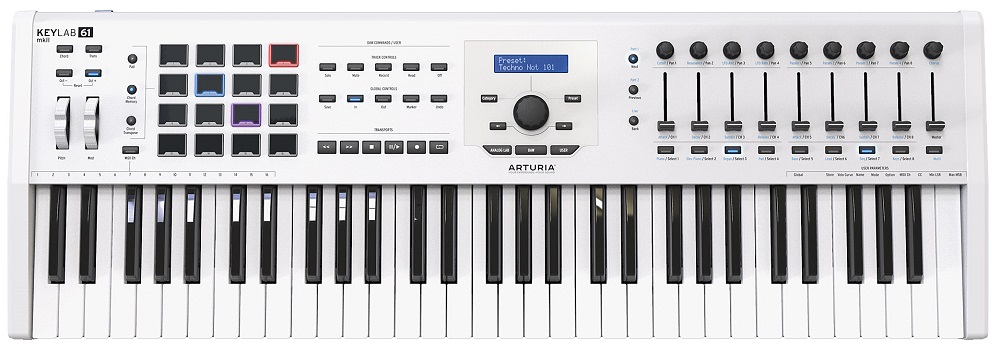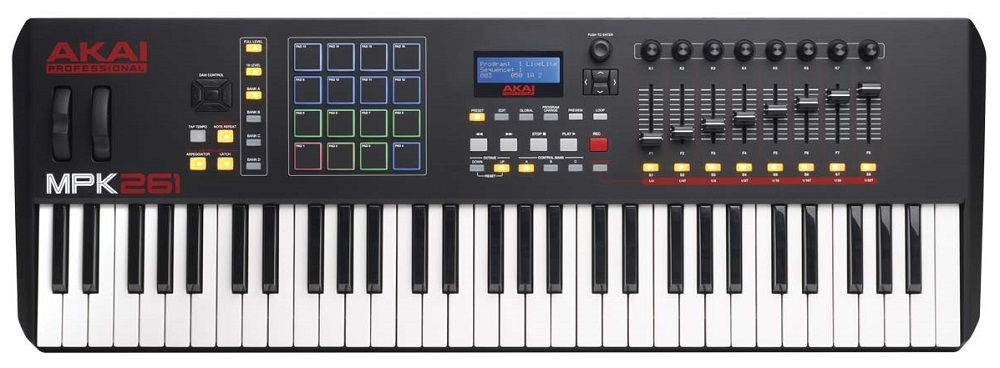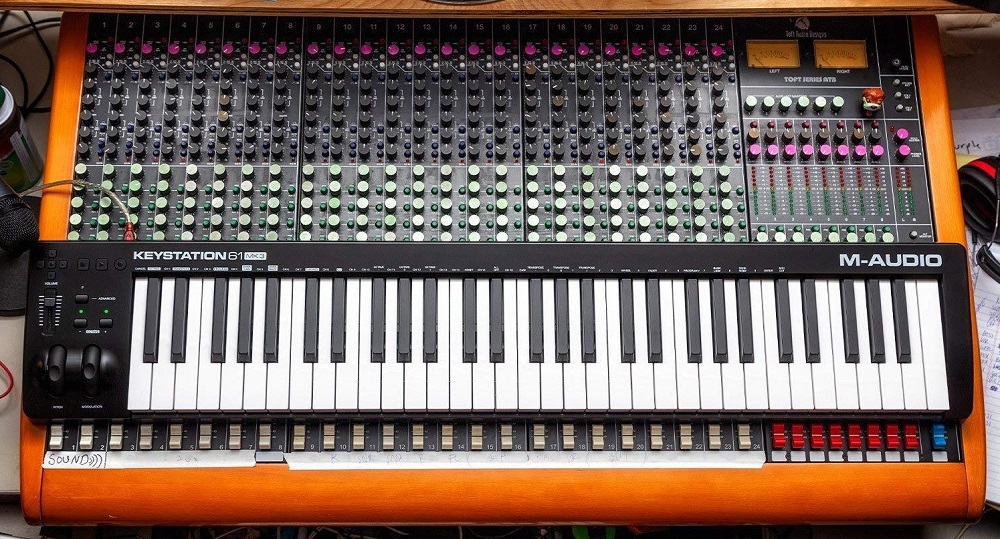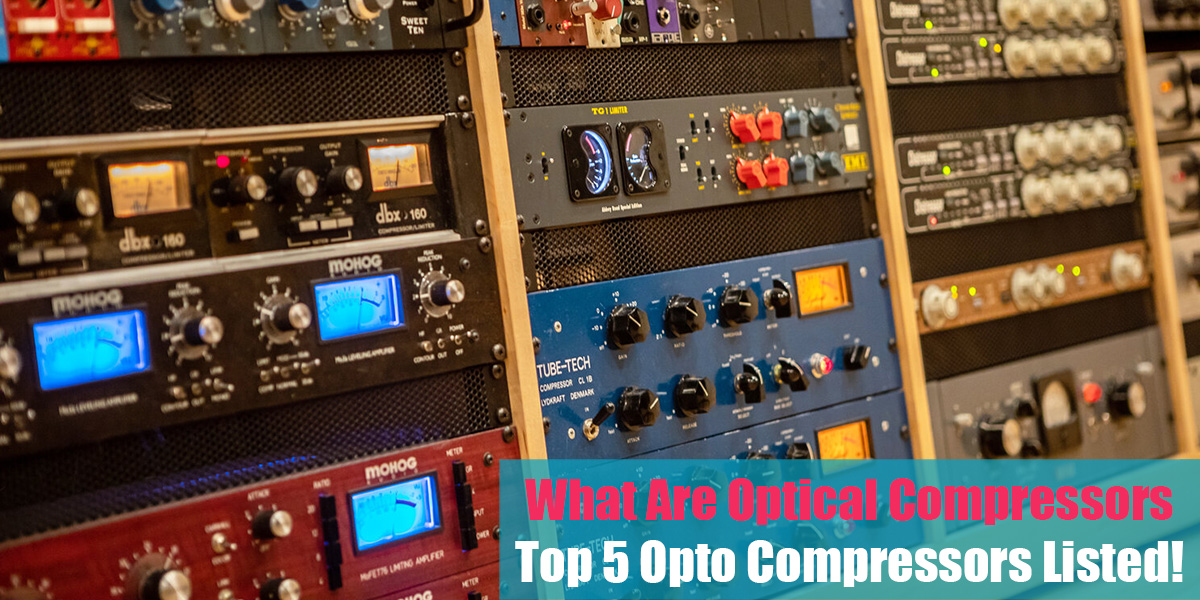Best MIDI Keyboards With 61 Keys
Introduction
If you browse our website, you’ll find several articles covering MIDI keyboards, including in-depth product reviews. We’ve already explored the best 25-key and 49-key keyboards, which are perfect for home and project studios. Now, we’re moving on from the smaller keyboards to something a bit larger.
In today’s article, we’re focusing on the top 11 MIDI keyboards with 61 keys. These keyboards are great because they provide enough space for both hands during arrangements, letting you play comfortably without constantly using the octave key. Plus, they take up less desk space than 88-key models.
When producing music, it’s important to consider the functions your keyboard offers. Each model comes with different features, depending on how the controls are set up. We’ve compared these models based on the number of pads, size, weight, keybed feel, functionality, and software integration.
A 61-key keyboard has several advantages over smaller options. It offers a more “pro” feel compared to 25-key models and feels much closer to playing a regular piano. Many 61-key keyboards also include advanced features that go beyond the basics, thanks to their larger size.
Just a quick note: we’re listing these best 61-key MIDI keyboards in no particular order. The list is randomized, as we don’t want to rank them from best to worst.
Listed below are our Top 11 MIDI Keyboard With 61 Keys:
1. Novation Launchkey 61 MK3
Ableton Live users can turn their DAW into an instrument with the Novation Launchpad series. Unlike traditional clip launchers, the Launchkey controllers combine clip launch buttons with synth-action keys.
The Launchkey 61 MK3 comes packed with features from the MK3 line, including new chord and scale modes, an arpeggiator, larger pads, and various hardware control improvements.
A major strength of this keyboard is its seamless integration with Ableton Live, whether you’re new to the Launchpad/Launchkey workflow or already experienced with it. While it may look complex at first, we found the Launchkey 61 MK3 to be intuitive for composing and arranging music.
It would be fascinating to add another layer of expression to this controller, similar to how a guitar responds to finger pressure while playing a note. Is this a reasonable feature request? Perhaps it will be possible in the Mark IV version.
Overall, the Launchkey 61 MK3 is an excellent, full-featured MIDI controller and clip launcher. It’s easy to integrate and gives you powerful compositional tools—especially if you’re a producer using Ableton Live.
You can create new sounds using the Launchkey app, an analog modeling synth with eight draggable nodes on the screen. This lets you turn your iPad into a powerful tool for live performances. The controller also boasts great build quality, with sturdy knobs and pads. It’s a versatile device that works well with all DAWs and many iOS applications.

- 61 Keys with velocity sensitivity
- 16 RGB illuminated velocity-sensitive pads
- Scale and Chord modes
- Arpeggiator
- Capture MIDI function
- MIDI mappings
| Amazon Store | ||||
|---|---|---|---|---|
Novation Launchkey 61 MK3 |
2. Native Instruments Komplete Kontrol S61
Despite its high price, the Komplete Kontrol S61 stands out as one of the most powerful options on the market. One of its biggest selling points is the inclusion of Komplete 12, an extremely valuable and expensive software package.
This keyboard features aftertouch, allowing you to fully explore its technical capabilities. If you enjoy adding vibrato, you can control the intensity simply by pressing the keys harder or softer. To run all of the included software smoothly, you’ll need a fast computer or laptop.
While the keys and software are outstanding, there’s one thing some users might miss: pads. This could be considered a drawback, but many producers don’t use pads in their workflow, so it may not be an issue for everyone.
The high-resolution screens are a particular highlight. Native Instruments MIDI controllers go above and beyond in this area, where most MIDI controllers take a more basic approach. Unlike standard displays, these screens are visually impressive and provide much more information in a clear, intuitive way.
There are several solid reasons why this is a premium choice. It’s arguably the best MIDI controller available, offering everything you need and more. If budget isn’t a major concern, this is an option you should definitely consider.
Investing in this MIDI controller is like buying a diamond: it may cost more upfront, but it will last for years and deliver far greater benefits than cheaper alternatives.

- For all virtual instruments
- Full VSTi support
- Two freely assignable inputs for foot pedals
- MIDI in/out
- Power supply via USB 2.0
- Dimensions (W x H x D): 1006 x 84 x 297 mm
Native Instruments Komplete Kontrol S61 |
3. Nektar Panorama P6
If you’re looking for a MIDI controller that feels like playing an electric keyboard or an acoustic piano, a model with a fully-weighted keybed and velocity sensitivity is a fantastic choice. This gives you the authentic feel of a real piano, while also providing the flexibility and control of a MIDI controller.
You’ll have endless musical possibilities at your fingertips with this controller. It boasts 93 real-time controls, letting you customize your sound every time you play. If you’re new to MIDI controllers, all these options might seem a bit overwhelming at first.
Luckily, the automapping feature makes this controller very user-friendly. With this function, the controller’s software can automatically assign each control to a default setting. This means you can start making music or adjust just a few settings, instead of having to configure everything from scratch.
Automapping is a huge time-saver when setting up your controller. It’s like having a built-in GPS, guiding you quickly and easily so you don’t waste time figuring things out.

- USB Controller-Keyboard
- Semi-weighted Keyboard with 61-Keys
- Velocity sensitive and Aftertouch
- Simensions: 990 x 330 x 101 mm
- Weight: 7,71 kg
| Amazon Store | ||||
|---|---|---|---|---|
Nektar Panorama P6 |
4. Arturia Keylab MKii 61
Among Arturia’s latest controllers, the KeyLab MKII stands out as one of the best. Following Arturia’s tradition, this keyboard also features aftertouch—a favorite among musicians across the industry.
If you’re searching for a keyboard that works seamlessly with Ableton, it’s hard to go wrong with the Arturia KeyLab 61 MKII.
From the moment you unbox the KeyLab, you’ll notice its premium feel. The white chassis with wooden side panels gives it a look that’s both retro and modern, easily outclassing many other products on the market.
The subtle pastel hue brings to mind classic synths from the 1980s. The layout is thoughtfully designed: pads and transport controls sit on the left, while the encoders and faders are on the right.
The build quality is undeniably excellent. The aluminum chassis adds strength without unnecessary weight, making it “tour-ready,” as Arturia claims. Weighing just over seven pounds, it’s one of the lightest 61-key keyboards available.
The keyboard is impressively lightweight, making it easy to carry, yet it still feels durable enough to handle regular use. It strikes the perfect balance between sturdiness and portability.

- 61 Velocity sensitive keys with aftertouch
- 16 Colour illuminated performance pads
- 9 Faders
- 9 Rotating control knob
- LC-Display
- Category function
| Amazon Store | ||||
|---|---|---|---|---|
Arturia Keylab MKii 61 |
5. M-Audio Oxygen 61 Pro
The Oxygen Pro 61 is a powerful, USB-powered MIDI controller with 61 keys that makes creating your own music easier than ever. With the new Oxygen Pro controllers, bringing your production ideas to life is simple and intuitive.
These controllers were designed based on feedback from users and artists, helping you stay focused on making music instead of programming your software. The M-Audio Oxygen Pro series offers flexible workflow options, whether you’re recording on the go or working in the studio.
Using the Oxygen Pro 61 with any DAW is easy, thanks to automatically mapped controls. This includes transport controls, faders, channel controls (record arm, solo, mute, and select), and pan controls.
Once you select your DAW and set the correct configuration, the Oxygen Pro 61’s controls will integrate seamlessly, whether you use Ableton, Pro Tools, MPC Beats, Cubase, Logic, Studio One, or any other major DAW.
Several virtual instruments are also instantly mapped to the Oxygen Pro 61, such as Velvet, Mini Grand, Hybrid 3, Tube Synth, Electric, and Bassline. With these Air Music Tech plugins, the Oxygen Pro 61 lets you control and mix your music in real time.

- 61 Velocity-sensitive, semi-weighted keys with aftertouch and assignable zones
- 16 RGB pads – backlit, assignable and velocity sensitive
- 8 Assignable controls and buttons
- 9 Assignable faders
- Dimensions (L x W x H): 965.2 x 264.2 x 83.8 mm
- Weight: 4.8 kg
| Amazon Store | ||||
|---|---|---|---|---|
M-Audio Oxygen 61 Pro |
6. Midiplus i61
Whether you’re on a budget or not, the Midiplus i61 keyboard controller is a great value. It comes with all the essential features you need in a key controller, all at a very affordable price.
This controller is powered by your computer’s USB port, so you only need one cable to set it up. Compared to other 61-key models, this unit is fairly compact. Keep in mind that it’s a basic model—it doesn’t make any sound on its own and must be connected to a computer or other MIDI equipment to operate your software.
If you’re new to key controllers, this could be just what you need. Its interface is simple and easy to use.
One thing to note is the USB cable included with the unit is a bit short, so you might want to get a longer one. Also, while the keys look full-sized, they’re actually a bit shorter than regular keys.
If you’re used to playing on full-sized keys, it may take a little time to get used to this controller. Although the unit doesn’t come with a manual, you can easily download one online.
Overall, this is a great budget MIDI controller with decent durability for the price, which is why we’ve chosen it as our top budget pick.

Midiplus i61 |
7. Korg microKEY Air
The microKEY Air from Korg is a slim, USB-powered MIDI controller keyboard featuring 61 velocity-sensitive Natural Touch mini keys and a pitch wheel.
It includes an assignable jack for connecting a sustain pedal, along with two octave-shift buttons to easily change the key range. You can download the free KONTROL Editor software from the Korg website, which lets you adjust various MIDI parameters.
This means you can customize the microKEY Air to fit your personal needs, such as changing the velocity curve to match how you play.
The controller also comes with the Korg Software Bundle. Additionally, when you purchase the Korg microKEY2, you’ll get access to a limited version of Reason.
Using the Korg KONTROL Editor’s MIDI mapping software, you can set a fixed velocity or choose from eight unique velocity curves, making it easy to tailor the microKEY2 to your playing style.
- Compact natural touch mini-keyboard
- Pitch Bend Wheel
- Modulation
- Octave Shift button
- Damper pedal connection
- Power supply via 2x AA battery or USB

| Amazon Store | ||||
|---|---|---|---|---|
Korg microKEY Air |
8. Akai Professional MPK261
Over the past few years, the Akai MPK261 has become one of the most popular MIDI keyboard controllers on the market. Akai is well known for making high-quality MIDI keyboards that appeal to musicians, producers, and keyboardists alike.
The interface is centered on the screen, while the pads are located on the left side. Personally, I prefer having the pads on the left. When pads are positioned on the right, it becomes difficult to trigger them while playing with my right hand.
The Akai MPK261 features velocity-sensitive keys and also includes an aftertouch function. If you enjoy exploring the full capabilities of a MIDI controller, you’ll find the aftertouch especially appealing. The MPK261 also offers RGB backlit pads in red, blue, and green, which are extremely helpful in dark music venues by illuminating the keyboard’s top.
For touring musicians, the MPK261 is an excellent choice. Akai has done an outstanding job creating keyboards that are both durable and reliable. As a MIDI keyboard, it’s lightweight and fairly robust.
However, if you’re considering upgrading from the original MPK series, it might be worth trying a different controller. The MPK261 hasn’t seen many upgrades compared to previous versions, so there may not be enough improvements to justify the higher cost.

- 61 Semi-weighted keys
- 16 MPC Pads with RGB lighting
- 8 assignable knobs, sliders and switches each
- Inputs for expression and sustain pedal
- Arpeggiator
- MPC Note repeat
| Amazon Store | ||||
|---|---|---|---|---|
Akai Professional MPK261 |
9. Nektar Panorama T6
With powerful VST, VST3, and AU instrument control in any VST/AU DAW, the Nektar Panorama T6 gives your virtual instrument plugins the feel and touch of hardware synthesizers. This is possible with the new Nektarine plugin control software, which comes with factory maps for many popular plugins. These maps are free to edit, and you can also create your own new maps.
Thanks to MCU support, nearly every DAW on the market lets you mix, select tracks, and control transport functions. Nektar DAW Controls Integration goes further, offering even deeper control over your DAW.
The Panorama T6 features a second-generation synth-action keyboard with medium tension and aftertouch, 8 highly dynamic LED drum pads, backlit transport controls, a custom LCD display, and new performance features. Creating rhythmic patterns is easy with highly customizable note repeats for both keys and pads. The powerful combination of software and hardware in the T-series delivers a level of control that is unmatched.
With Nektar’s Nektarine DAW Integration software, system integration is taken to a whole new level. To provide you with an integrated workflow that makes it easy to access transport and mixer functions, as well as control your DAW’s internal instruments, Nektar develops custom software for each supported DAW.

- 8 Impact and pressure-sensitive pads
- Bank button for access to another 8 pads
- 9 Fader 30 mm
- 8 Assignable LED buttons and 8 encoders
- Each controller is fully programmable
- Chord function: Trigger up to 6 notes via a key or pad
| Amazon Store | ||||
|---|---|---|---|---|
Nektar Panorama T6 |
10. M-Audio Keystation 61 MK3
When it comes to the features of the MK3, “what you see is what you get.” If a function isn’t listed above a key, you probably won’t be able to adjust it. Keystation is designed to minimize reliance on software for simple settings, while keeping the number of buttons as low as possible.
The Advanced key is central to this streamlined design. By pressing “Advanced,” you can select a parameter to adjust with the +/- buttons (which default to octave +/-), or choose an immediate option like setting the MIDI channel.
Keystation 61 MK3 features an intuitive control layout for easy session navigation. On the left side of the keys, you’ll find controls for pitch, modulation, and octave. The dedicated Volume slider is great for live performance and studio work, and can be assigned to control any MIDI value—such as adding expression or sweeping a filter during a recording.
With dedicated transport controls and cursor keys, you won’t need to rely on your mouse. This makes the Keystation 61 MK3 an excellent choice for streamlined studio setups and live performance environments.

- 61 Velocity-sensitive keys
- Pitch bend and modulation wheel
- Octave selection
- Transport button for DAW control
- Dimensions: 995 x 189 x 68 mm
- Weight: 4.1 kg
| Amazon Store | ||||
|---|---|---|---|---|
M-Audio Keystation 61 MK3 |
Best 61 Keys MIDI Keyboards – Latest Additions
11. Alesis V61 MKII
A comprehensive range of USB keyboard controllers offers the ideal interface for entering notes and tweaking parameters, and the new Alesis controller keyboard series delivers an impressive blend of features and affordability.
There are three keyboard sizes to choose from: 25, 49, and 61 keys. Although the keys are semi-weighted, the keyboard provides both velocity and aftertouch control. While the key action isn’t the most advanced, it is comfortable enough for extended playing and note input.
MIDI connectivity is available via a USB port on the rear panel, along with traditional MIDI Out and Sustain ports, plus a 9V power input.
However, the V61’s standout feature is its extensive range of control options and pads. Its design is simple, straightforward, and flexible. In short, this quiet yet highly impressive keyboard controller is ready to meet all your playing and control needs right out of the box.

- 61 Velocity-sensitive keys
- Arpeggiator with 6 modes
- Tap tempo and adjustable time division
- Gate and Swing
- 4 Assignable knobs
- Pitch bend and modulation wheels
| Amazon Store | ||||
|---|---|---|---|---|
Alesis V61 MKII |
Is a 61-key MIDI Controller enough?
If you’re playing one-handed synths or bass lines, a 25-key keyboard is a great choice. However, when arranging a piano piece, you’ll need 61, 76, or even the full 88 keys. The most popular size for MIDI controller keyboards is 61 keys, which is large enough for comfortable two-handed playing.
Guide for Getting a 61-key MIDI Controllers
In selecting a keyboard or digital piano, you should consider several factors, whether you are shopping in your local music store or browsing through online retailers like Amazon, Sweetwater, or another store in your area.
Several factors should be considered when selecting an instrument: the size and number of keys, whether the keys are weighted, whether the instrument uses MIDI, and whether it is new or used.
Number of keys
Keyboard models vary in terms of the number of keys they contain. You can play a wider range of notes the more keys you have on your keyboard. It is important to consider both your experience with keyboard playing as well as the available space when choosing the number of keys.
66 keys is a good starting point for beginner keyboard players, which is sufficient to learn the basics of piano and keyboard playing as well as play a variety of songs. Despite this, a smaller instrument can be used for a wide variety of purposes.
Full-sized vs compact keyboard
What is the size of the keyboard you are looking for? Consider some of the smaller digital pianos and keyboards available on the market, or the so-called compact keyboards, if you intend to carry your instrument around a lot or have limited space. It is likely that a smaller keyboard will have fewer keys than a larger one, but it will be lighter and more portable.
Weighted keyboards
Keyboards with weighted keys are similar to acoustic pianos with weighted keys. It is often referred to as a digital piano when these types of keyboards sound similar to an acoustic piano. In the event that you are accustomed to playing an acoustic piano and do not feel comfortable changing to an electric keyboard, playing with weighted keys may be a good choice.
MIDI
In any home studio, MIDI keyboards (short for Musical Instrument Digital Interface) are an essential piece of equipment. There is a great advantage to using MIDI keyboards in that they can be connected to your computer or another device via a physical connection or even wirelessly via Bluetooth – also with MIDI input and MIDI output. In addition to being available in a variety of sizes, MIDI keyboards also fall within a broad range of price ranges.
Rewritten:
When choosing a keyboard or digital piano, there are several important factors to keep in mind, whether you’re shopping at your local music store or browsing online retailers like Amazon, Sweetwater, or other stores in your area.
Consider aspects such as the size and number of keys, whether the keys are weighted, if the instrument supports MIDI, and whether you want a new or used model.
Number of keys
Keyboards come with different numbers of keys. The more keys your keyboard has, the broader the range of notes you can play. When deciding how many keys you need, think about your experience level and how much space you have available.
For beginners, 66 keys are a great starting point. This is enough to learn the basics of piano and keyboard techniques and to play a wide selection of songs. However, smaller keyboards can still serve many purposes.
Full-sized vs compact keyboards
Are you looking for a full-sized or a compact keyboard? If you plan to move your instrument around a lot or have limited space, consider smaller digital pianos or so-called compact keyboards. While these usually have fewer keys, they are lighter and more portable.
Weighted keyboards
Keyboards with weighted keys mimic the feel of an acoustic piano. These are often called digital pianos, especially when they also sound similar to acoustic pianos. If you’re used to playing a traditional piano and want a similar feel, a keyboard with weighted keys could be the right choice.
MIDI
MIDI keyboards (Musical Instrument Digital Interface) are essential for any home studio. One of their main advantages is that they can connect to your computer or other devices, either through a cable or even wirelessly via Bluetooth. MIDI keyboards come in many sizes and price ranges, making them versatile and accessible for various needs.

Conclusion
We’ve rounded up 11 of the best MIDI controller keyboards and put together a quick buyer’s guide to help you choose the right one. There are a few important features to keep in mind: look for full- or semi-weighted keys, modulation and pitch bend wheels, audio interface options, sustain pedal input, and sometimes bundled software like Logic Pro, Ableton, or Cubase.
Here, you’ll find our top picks for 61-key MIDI keyboard controllers, each with impressive features for music production. If you’re ready to level up your setup, any of these choices will serve you well. Our two top recommendations are the Native Instruments and Panorama P6 models. For those on a budget, check out the 11th keyboard on our list—the Alesis V61 MKII, which is also the newest addition.
If you have any questions about these models or MIDI controllers in general, feel free to ask in the comments below. We’re happy to help and provide more information!
{ “@context”: “https://schema.org”, “@type”: “ItemList”, “name”: “Top 11 Best MIDI Keyboards With 61 Keys! (Updated 2023)”, “description”: “This article will go over the best MIDI keyboards with 61 keys and we are sharing brief reviews on each model + brief buyers guide!”, “itemListElement”: [ { “@type”: “ListItem”, “position”: 1, “name”: “Novation Launchkey 61 MK3”, “url”: “https://themixingtips.com/best-midi-keyboards-with-61-keys/#1_Novation_Launchkey_61_MK3” }, { “@type”: “ListItem”, “position”: 2, “name”: “Native Instruments Komplete Kontrol 61”, “url”: “https://themixingtips.com/best-midi-keyboards-with-61-keys/#2_Native_Instruments_Komplete_Kontrol_61” }, { “@type”: “ListItem”, “position”: 3, “name”: “Nektar Panorama P6”, “url”: “https://themixingtips.com/best-midi-keyboards-with-61-keys/#3_Nektar_Panorama_P6” }, { “@type”: “ListItem”, “position”: 4, “name”: “Arturia Keylab MKii 61”, “url”: “https://themixingtips.com/best-midi-keyboards-with-61-keys/#4_Arturia_Keylab_MKii_61” }, { “@type”: “ListItem”, “position”: 5, “name”: “M-Audio Oxygen 61 Pro”, “url”: “https://themixingtips.com/best-midi-keyboards-with-61-keys/#5_M-Audio_Oxygen_61_Pro” }, { “@type”: “ListItem”, “position”: 6, “name”: “Midiplus i61”, “url”: “https://themixingtips.com/best-midi-keyboards-with-61-keys/#6_Midiplus_i61” }, { “@type”: “ListItem”, “position”: 7, “name”: “Korg microKEY Air”, “url”: “https://themixingtips.com/best-midi-keyboards-with-61-keys/#7_Korg_microKEY_Air” }, { “@type”: “ListItem”, “position”: 8, “name”: “Akai Professional MPK261”, “url”: “https://themixingtips.com/best-midi-keyboards-with-61-keys/#8_Akai_Professional_MPK261” }, { “@type”: “ListItem”, “position”: 9, “name”: “Nektar Panorama T6”, “url”: “https://themixingtips.com/best-midi-keyboards-with-61-keys/#9_Nektar_Panorama_T6” }, { “@type”: “ListItem”, “position”: 10, “name”: “M-Audio Keystation 61 MK3”, “url”: “https://themixingtips.com/best-midi-keyboards-with-61-keys/#10_M-Audio_Keystation_61_MK3” }, { “@type”: “ListItem”, “position”: 11, “name”: “Alesis V61 MKII”, “url”: “https://themixingtips.com/best-midi-keyboards-with-61-keys/#11_Alesis_V61_MKII” } ] }






